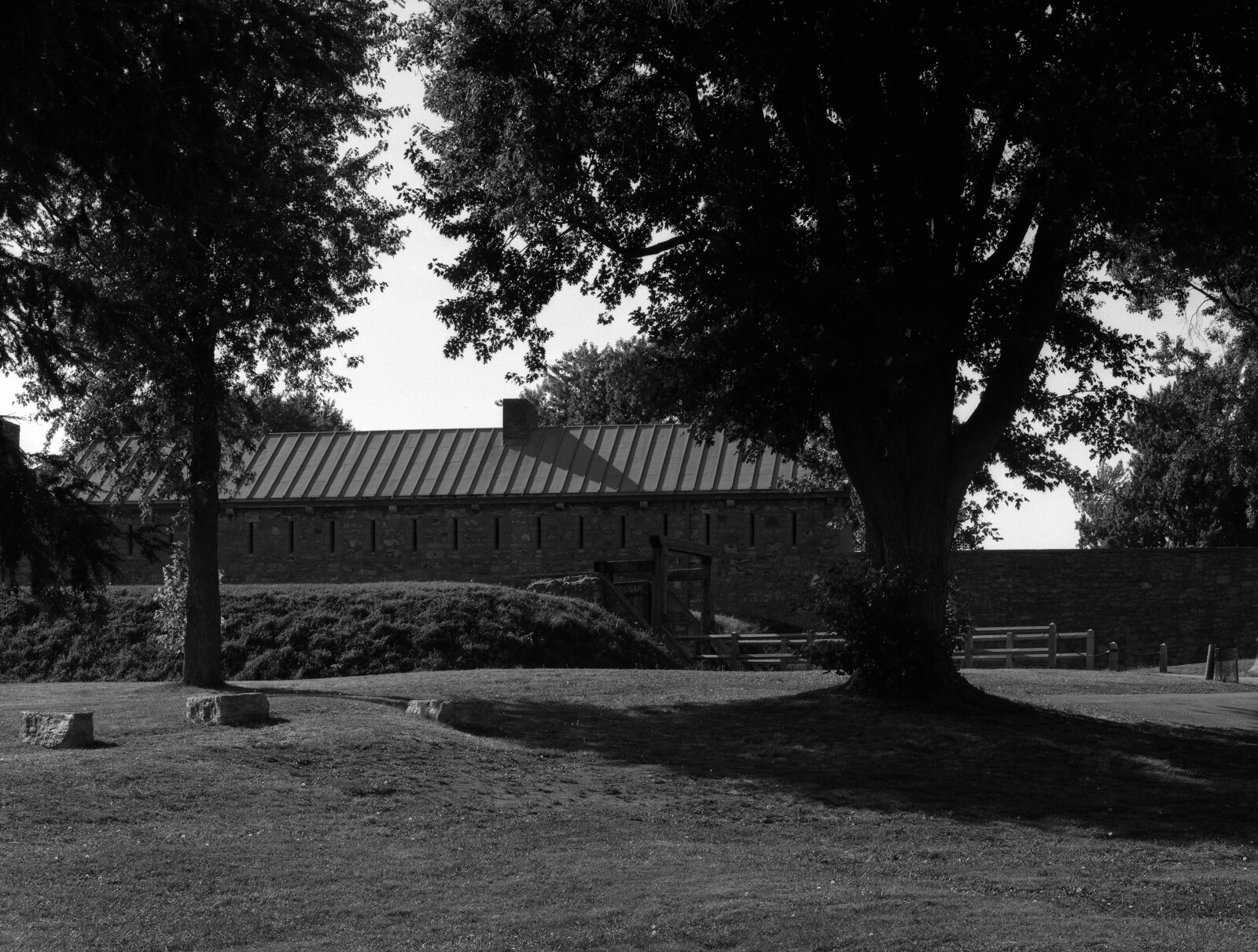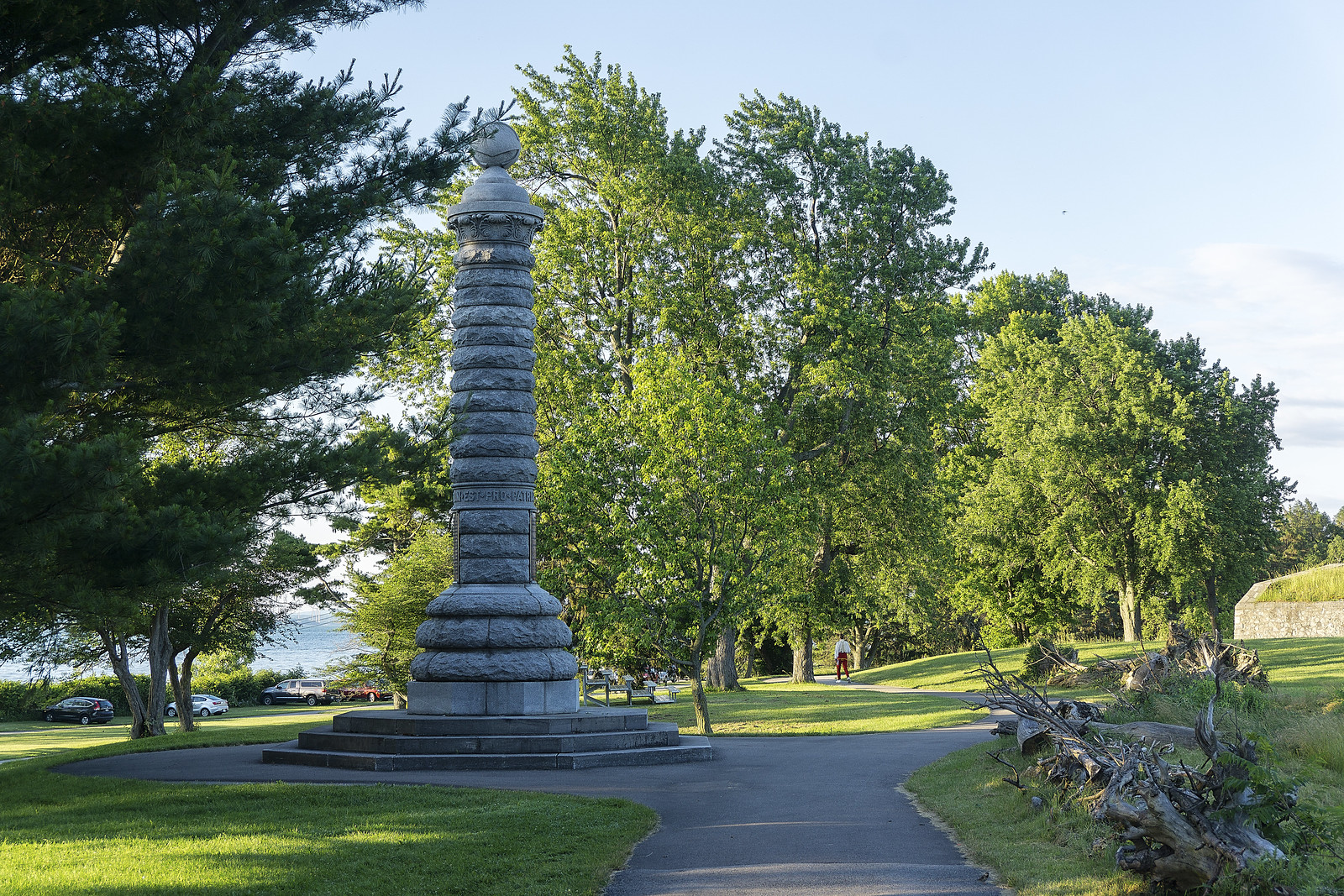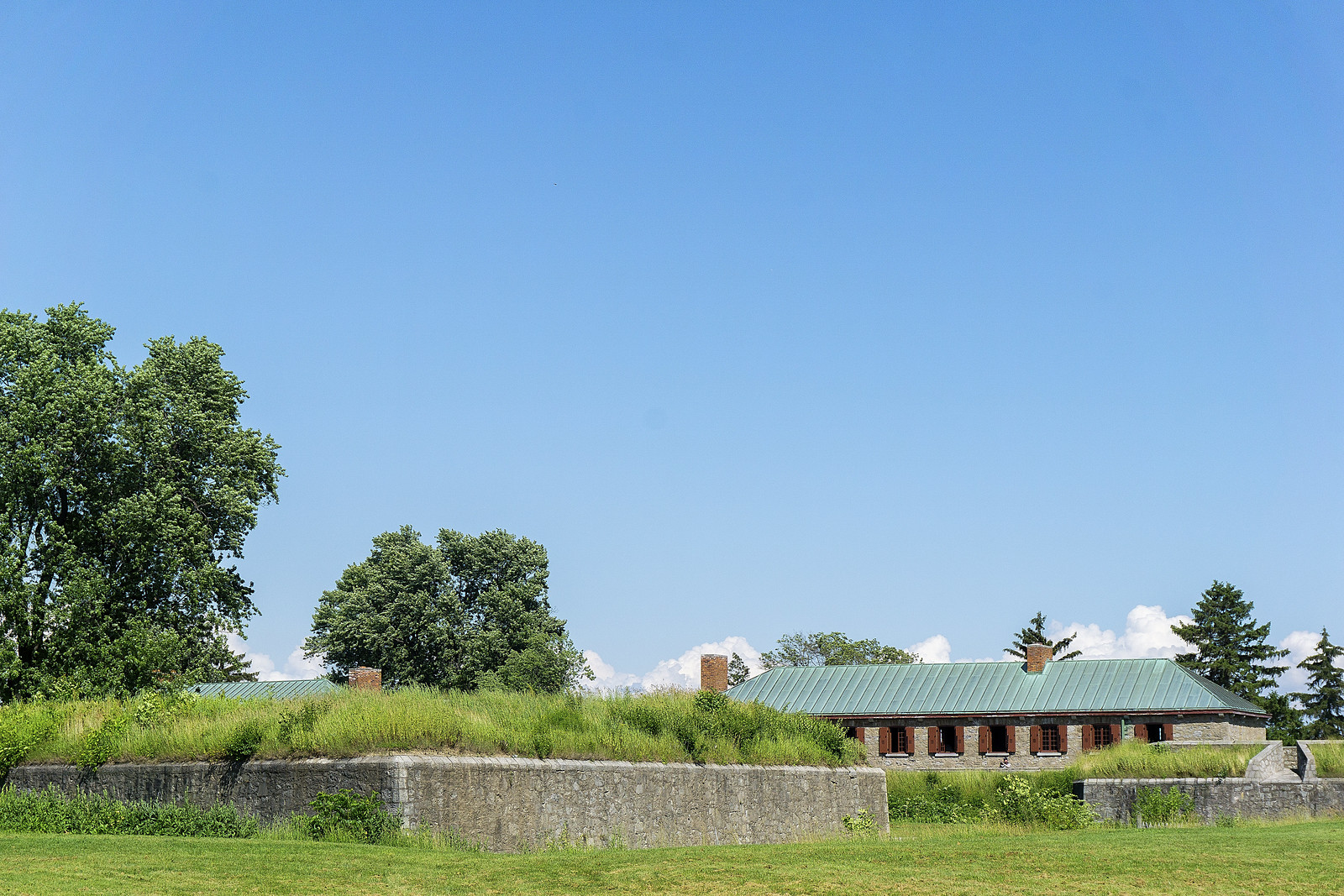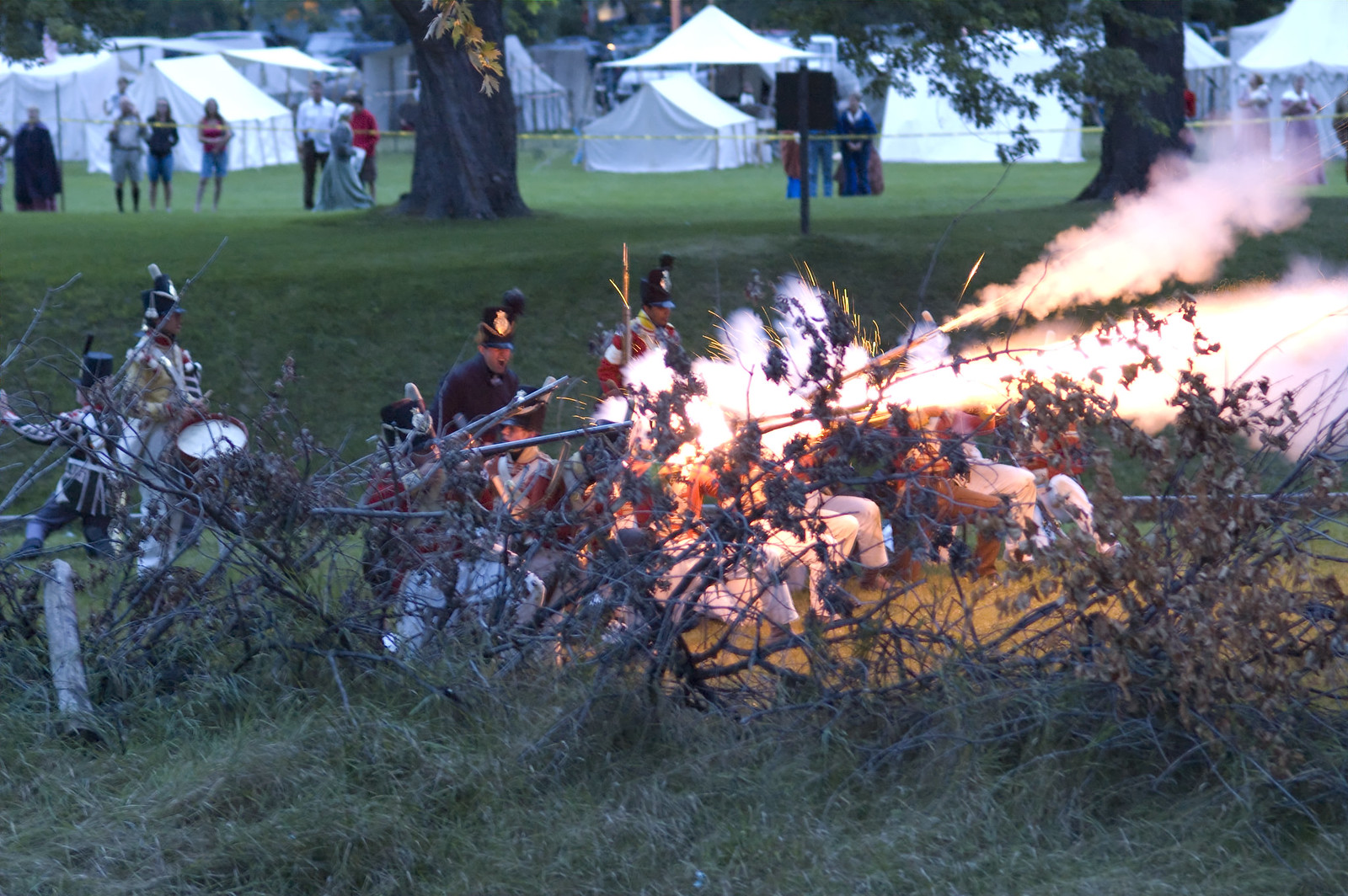If you’ve ever crossed from Canada into the United States through one of the four land crossings in the Niagara Region, or have been shopping in Buffalo, there is an excellent chance that one of those crossings took place at Fort Erie on the Peace Bridge. If you’ve ever wondered how the small town got that name, take a drive just past the Mather Arch along Lakeshore Road, and you’ll find a small squat stone fort standing on a hill above Lake Erie. This is Olde Fort Erie and the source of the town’s eventual name of Fort Erie. The Old Fort is also one of the only Fort built in Canada that remained British after the American Revolution as it was built on the other side of the Great Lakes, which became the official treaty line after the signing of the Jay Treaty in 1798. But the Fort that you see today is not the original Fort. Instead, it is a modern reconstruction of the completed American Fort in 1814.

Modified Anniversary Speed Graphic – Kodak Ektar f:7.7 203mm – Ilford Delta 100 @ ASA-100 – Kodak Xtol (Stock) 8:00 @ 20C
The British identified the area as being of strategic importance as it sat high above Niagara Falls and made sense to build a small fortification to ensure a secondary Portage Route around Niagara Falls. These efforts were made following the capture of New France during the Seven Years War (or French and Indian War for those in North America). While the British had successfully captured Fort Niagara in 1759, they needed to ensure a safe supply route for commercial and military supplies. The Primary course stood between Fort Niagara and Fort Schossler on the American side of the Great Lakes. The first Fort Erie (named for the Lake it sat next to) opened in 1764. And sat far closer to the Lake on lower ground than the current structure. This original structure was damaged in a winter storm, the army quickly rebuilt in the same location. The original designs called for a far larger complex, but only a small primarily wooden and earthwork structure had been completed. By 1795, the Fort had several wooden blockhouses and a wooden palisade wall. Dropped from construction were a stone magazine and officers’ quarters. The Fort continued to serve as a troop and supply depot through the American Revolution. A winter storm also wiped this Fort off the map in 1803. By this time, the British Army had been forced to turn over several of the other forts on the American side and were building several new Forts but took the chance and began building a third Fort. This time, they would build the Fort using the readily available flintstone and on higher ground.

Sony a6000 – Sony E PZ 16-50mm 1:3.5-5.6 OSS
Sony a6000 – Sony E PZ 16-50mm 1:3.5-5.6 OSS
When the Anglo-American War of 1812 opened, the Fort had not yet been completed. The years of peace had made the thought of a renewed conflict with the United States a minor concern. The British Army had a far larger threat closer to home. France torn apart by Revolution launched a series of wars which were continued by Napoleon. During the first year of the war, much of the action took place far from the incomplete Fort which held only a small garrison while work continued in hast to complete the fortification. The garrison did help keep an American probe to a potential invasion at bay in what is known as the Skirmish of Frenchman’s Creek in November of 1812. Troops successfully engaged American troops at two satellite batteries at Frenchman’s Creek and the Red House. When the Americans invaded the Peninsula in May of 1813, they assaulted at Fort George and eventually forced the surrender of the British Army in the region, all British Forces, including the ones at Fort Erie (which remained incomplete) were forced to march towards the new Fort at Burlington Heights. Although during the 1813 invasion, the Americans never occupied the unfinished works. And following the Battle of Stoney Creek and the steady force back, the British again occupied the Fort and used it as a base for a series of raids into Buffalo in late 1813.

Sony a6000 – Sony E PZ 16-50mm 1:3.5-5.6 OSS
Sony a6000 – Sony E PZ 16-50mm 1:3.5-5.6 OSS
Although the luck of the Fort did not change, while work again continued in 1814 to complete the post, the invasion of a new American Army under General Jacob Brown found the incomplete post under siege. The garrison, under the command of Major Buck and occupied by elements of the 8th (King’s) Regiment of Foot finding themselves in no position to defend the Fort to the last man surrendered the post to the invading American Army. General Brown and his second General Winfield Scott wasted no time. They began the rapid completion of the Fort and expansion of the defences. The original stone fort saw completion, with both stone and earthen walls, two stone blockhouses, a dry ditch, gates, and artillery soon covered most angles of attack. But the American Engineers did not stop there. Large Earth batteries were built along earthwork walls. The first being the Douglass Battery the second Snake Hill Battery. General Brown needed a significant beachhead and fall back position should his invasion fail. The Americans would win a string of victories pushing the British back to Queenston Heights. Only to be forced to fall back after the bloody battle of Lundy’s Lane. The British, now under the command of General Gordon Drummond, pushed steadily back and quickly surrounded Fort Erie for a prolonged siege by August 1814. The trouble remained that General Drummond had neither the firepower nor the men to lay siege effectively, and the American defences proved far more than the British forces could manage. Drummond would launch a bloody by ineffective infantry assault against the Fort later in August. The action would name Fort Erie as one of the bloodiest battlefields in colonial Canada. The assault saw mass casualties but also destroyed the Fort’s magazine at the battle’s climax. The two sides would return to exchanging artillery fire and launched punitive tactical raids against each other. Unable to hold the siege, the British fell back to Chippawa keeping the Americans at bay. Unwilling to remain in Canada through the winter, the Americans destroyed the Fort and returned to Buffalo in November. The British would reoccupy the Fort with Captain James FitzGibbon leading a small force to ensure the Fort’s safety.

Sony a6000 – Sony E PZ 16-50mm 1:3.5-5.6 OSS
Sony a6000 – Sony E PZ 16-50mm 1:3.5-5.6 OSS
When word of the end of the War in May of 1815 reached Canada, the British would set up a small garrison in the ruins of Fort Erie. But with a larger fortification being completed in Niagara, the site was rarely occupied and became more of a fair-weather post. The locals began to use the old Fort as a park and picnicking place. It even saw a visit in the 1860s by the future King Edward VII during a visit to Canada. Tensions with the United States again required the occupation of the old Fort, this time by the Royal Canadian Rifle Regiment and local Militia units. And while the Trent Affair was quietly resolved the threat of an American invasion remained. And it did come, but not by the Americans. Rather the Fenians, a group of Irish who desired to invade and hold Canada hostage for Independence of their home island from the English. In July 1866 a sizeable Fenian force crossed the river from Buffalo invading and occupying the village and the old Fort, using it as an armed camp and impromptu prison for Militia troops captured in the initial invasion and the Battle of Ridgeway. The invasion ended as quickly as it started. Locals quickly returned the land to a far peaceful use as a park. Builders would also raid the fort ruins for stone. After the destruction of their wooden church, St. Paul’s Anglican Church built a new stone sanctuary using these stones.

Nikon D70s – AF Nikkor 85mm 1:1.8D
Nikon D70s – AF Nikkor 85mm 1:1.8D
Throughout the 1920s and 1930s, the Canadian Government began to take steps to start marking important historical sites and rebuilding several older buildings. Among those were several colonial forts. Restoration of Olde Fort Erie began in 1937. Using the original British plans from 1803, the reconstructed Fort was built as it would have appeared in 1814 during the American invasion and occupation. The only things not restored were the Douglass and Snake Hill batteries. During this work, a mass grave was uncovered and the bodies, both British and American, were reinterred and a monument raised over the site listing many of the names of the dead. The site opened in 1939 under the Niagara Parks Association as a public park and museum. The Fort became known for its presence of ghosts, and a great many ghost stories quickly made their way into the public eye and the mythos of the Fort as a museum. Archaeological digs through the 1980s found a second mass grave at the Snake Hill Battery site, including a pair of bodies, one missing ahead, the hands of the other. These bodies were found to be all American troops and were properly carried over and buried with full honours in Buffalo. The 1980s also brought the first reenactments to the site with men and women doing their best to honour those who fought and died during the bloody siege of 1814. The latest updates to the Fort took place in 2011 in the lead up to the bicentennial a new visitor’s centre and a museum was completed that only adds to the experience of visiting the old Fort Along with recreated siege works leading up to the entrance of the Fort.

Nikon D300 – AF-S Nikkor 70-200mm 1:2.8G VR
Nikon D300 – AF-S Nikkor 70-200mm 1:2.8G VR
While I have never visited the Fort as a tourist, I can say it’s well worth the trip. The site is beautiful and is among one of the most photogenic forts in Canada, especially in the winter. While it only operates during the late spring to early fall, you can still visit the site year-round. Just don’t trespass on the site if the gates are closed. Some of my first experiences in learning more about the Anglo-American War of 1812 took place here at Fort Erie and my first experience with the Reenactment Hobby as a whole. I fielded for the first time in the full uniform of the 60th Regiment of Foot at the Annual Siege Event. While I don’t consider it my ‘home’ fort, it still holds a particular spot in my heart. If you’re interested in seeing more from the past Seige Events, you can find all my albums over on Flickr. I’ve photographed the events in 2008, 2009, 2010, 2011, and 2018.
With Files from:
Web: www.niagaraparks.com/old-fort-erie/history.html
Guidebook to the Historic Sites of the War of 1812 Second Edition by Gilbert Collins – 2006 The Dundurn Group Publishers
Hickey, Donald R. Don’t Give up the Ship!: Myths of the War of 1812. Urbana: U of Illinois, 2006. Print.
Hickey, Donald R. The War of 1812: A Forgotten Conflict. Urbana: U of Illinois, 1989. Print.
Lossing, Benson John. The Pictorial Field-book of the War of 1812. Gretna, LA: Pelican Pub., 2003. Print.
Berton, Pierre. Flames across the Border, 1813-1814. Markham, Ont.: Penguin, 1988. Print.